Table of Contents
- Table of Contents
- Objectives
- Structure of the Team
- Video Submission
- Qualification
- The Arena
- Tasks
- Specification of AUV
- Game Procedure
- Certificate of Participation
- General Restrictions
- Disqualification
- Others
- Feedback
Objectives
The goal is for each team to develop an Autonomous Underwater Vehicle (AUV) which can negotiate the tasks put forth under a prescribed time and at the same time, to learn about underwater robotics and have fun in the process.
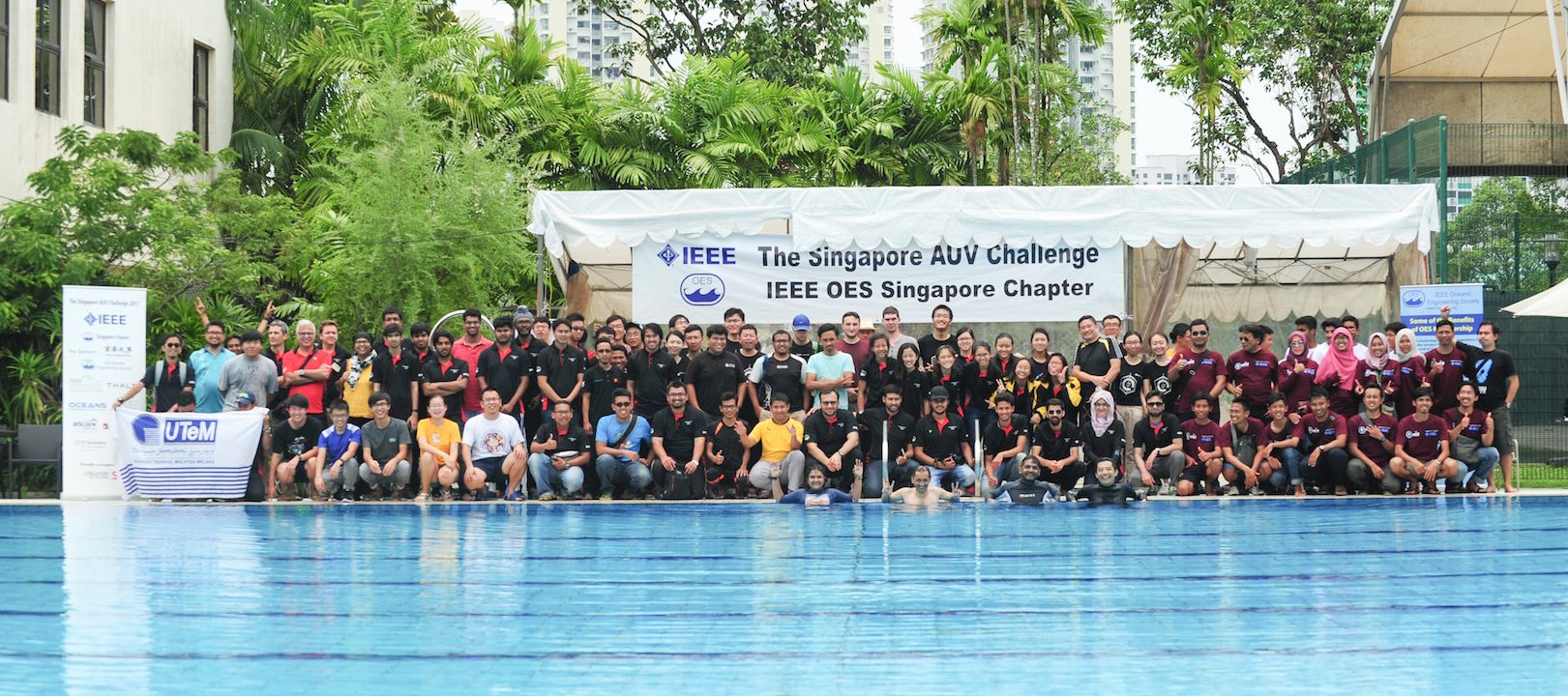
The SAUVC 2017 Participants.
Structure of the Team
A team may consist of up to 11 participants including faculty supervisors. At least half of the participants must be full-time students at the time of registration.

One of the teams with faculty co-supervisors from the 2017 Competition.
Video Submission
All teams have to submit a video of their AUV prior to the competition. The video HAS TO
- be maximum 30 seconds long,
- be submitted before 23:59 30th November, 2024, Anywhere On Earth,
- showcase the tether-less operation of AUV swimming underwater for at least 10 seconds.
- show clearly that someone pressing the Kill Switch should stop all thrusters immediately.
Note: The video will not be played beyond 30 seconds, so whatever you want to showcase, must be done strictly within the 30 seconds.
Donts: For your video, DO NOT
- put the most important parts of the video after 30 seconds (safety, control etc.), as it will not be reviewed, without exception.
- you do not need to showcase an intro of team structure, university details etc - this will only take up valuable time in your video.
Videos will be reviewed by the organizing committee and 35 teams with the best vehicles will be short-listed to attend the competition. The above criteria are the basic necessary criteria, failing which the teams wont be short-listed.
The organizers reserve the right to publish the video submissions after the competition.
Qualification
- To qualify, an AUV must swim from the qualification starting line, pass completely through the qualification gate, perform a U-turn, and completely pass through the gate again. Note: It is necessary to perform a U-Turn after passing through the gate in the forward run, before attempting the reverse run.
- "Passing through the gate" implies the back-most part of the AUV crosses the line.
- The AUV must complete the entire course without surfacing, touching the bottom, walls, or the qualification gate.
- Passing through the gate once (in the forward run) earns 1 qualification point. 2 qualification points are awarded only after the AUV passes through the gate both times (i.e, on both the forward and reverse run).
- The total run time will be measured from when the AUV starts the qualification run to when it completely passes through the gate for the second time or when the team requests an abort.
- Timing of the run will be used for tie-breakers only and does not directly contribute to the qualification score.
- Teams will be allocated a time slot for the qualification round. Teams may attempt multiple qualifying runs during the qualifying slot.
- If multiple qualifying runs are attempted during the qualifying slot, the most successful run will be considered for the final round (i.e the run with highest qualification points, and the fastest amongst those).
- Only the top 15 qualified teams, with the highest qualification score, will advance to the final round.
- The qualification score, followed by the time taken to pass the qualifier round, decides the sequence in which the teams will participate in the final round of the competition. The team that finished the last in the qualifying round would participate first in the final round.
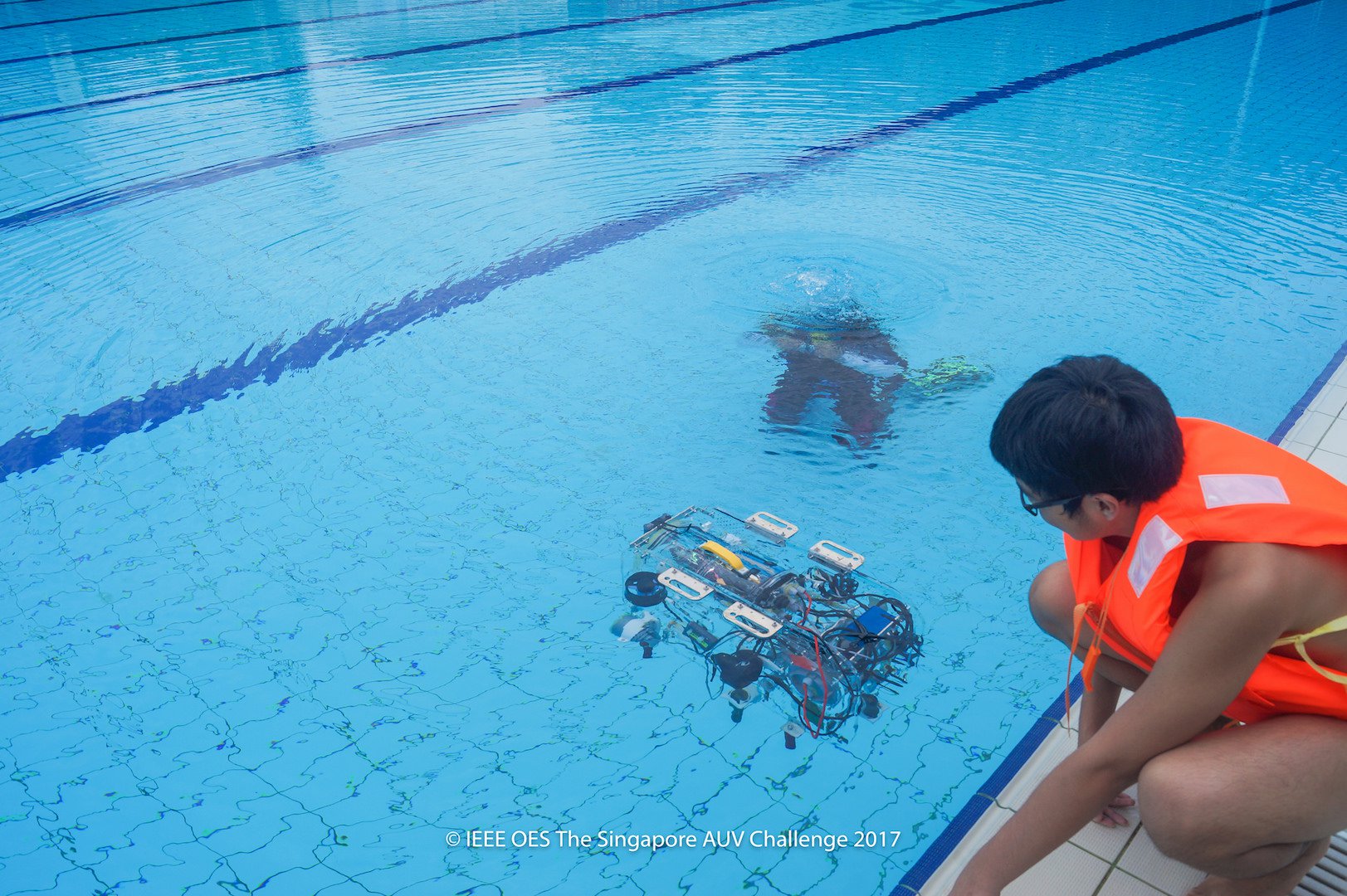
A team attempting qualification in the 2017 Competition.
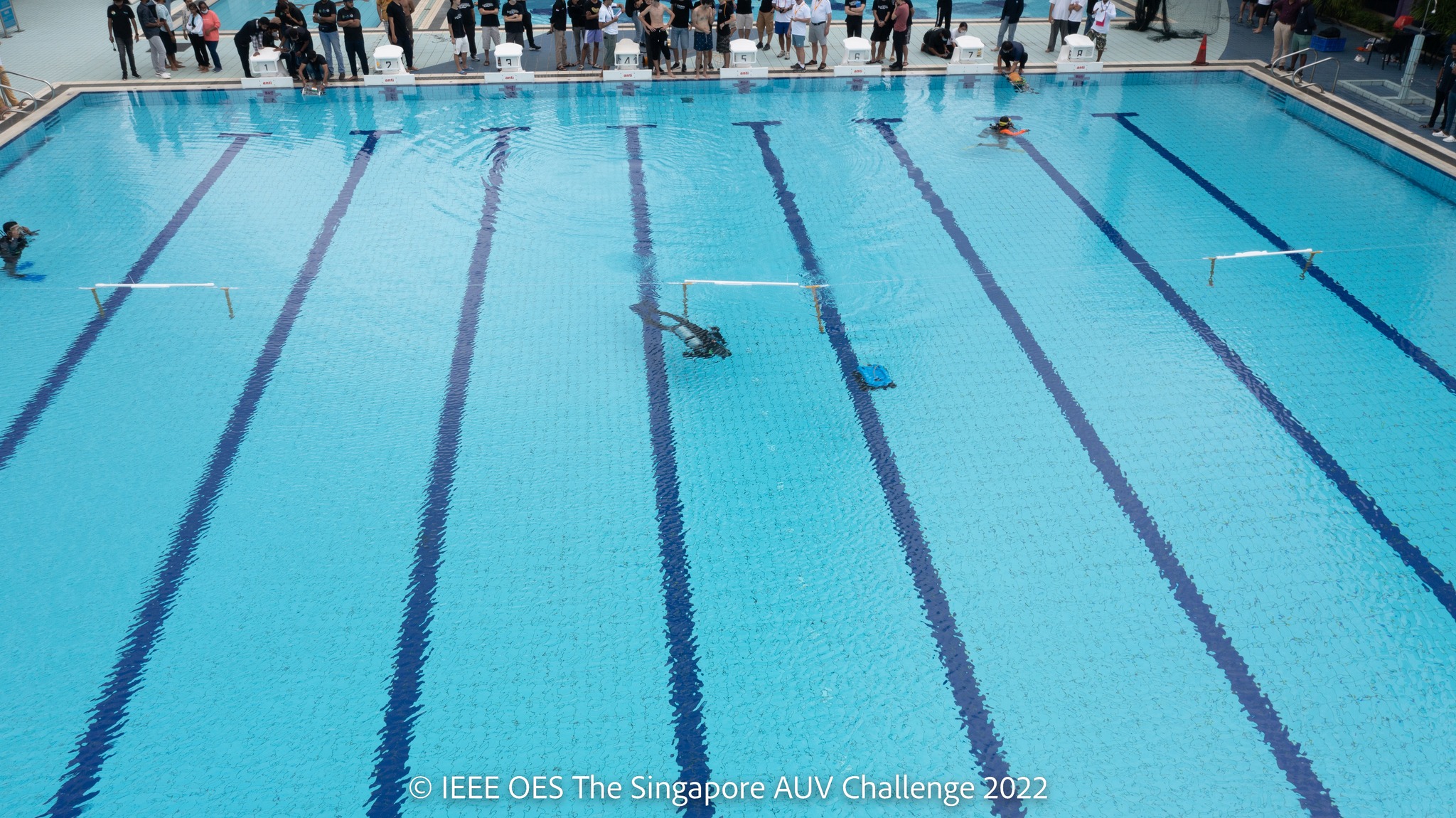
Top view of the qualification areanas from the 2022 Competition.
The Arena
The challenge will be held in an olympic sized swimming pool (50m x 25m).
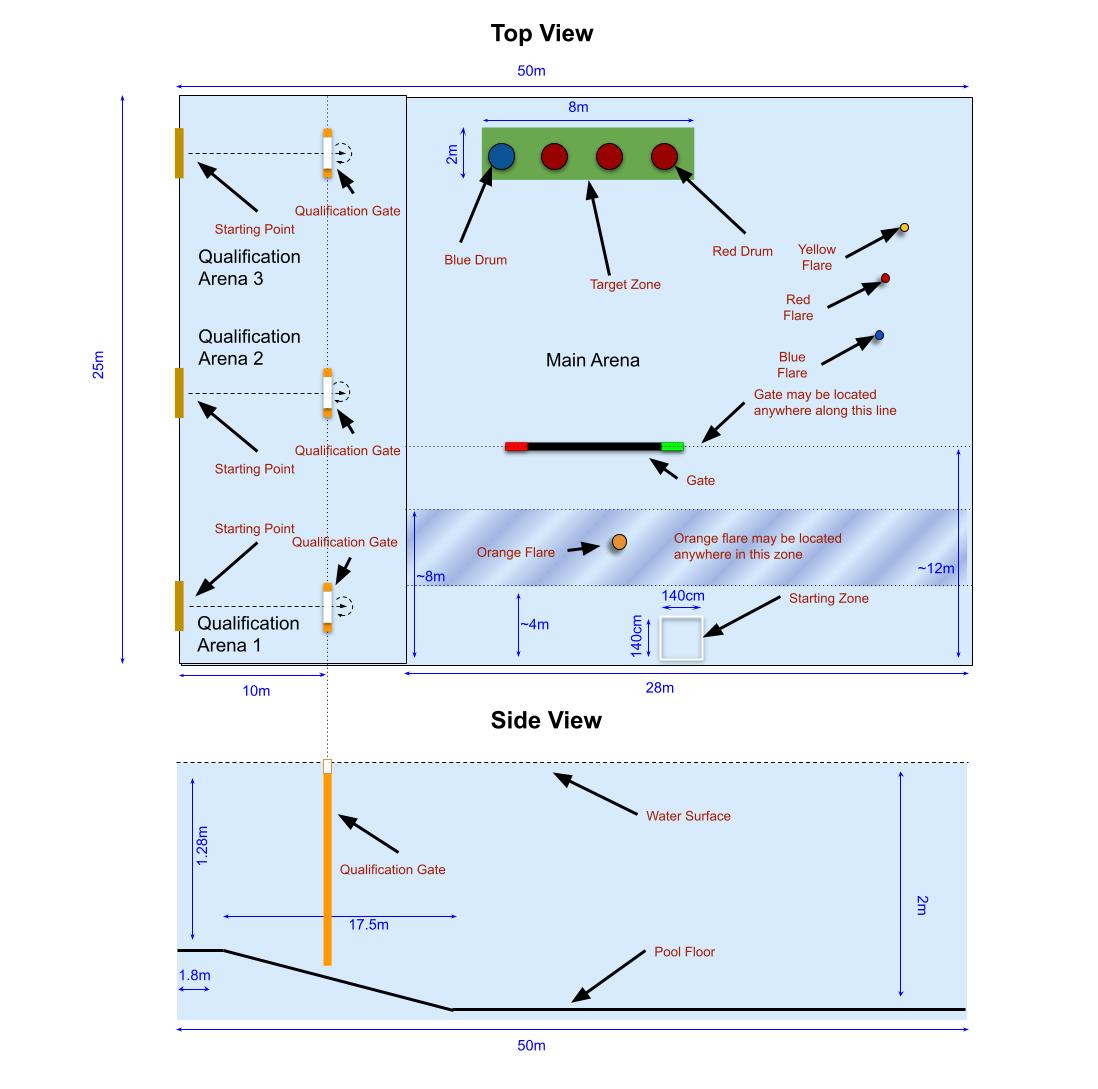
Top & side views of the Arena (not to scale).
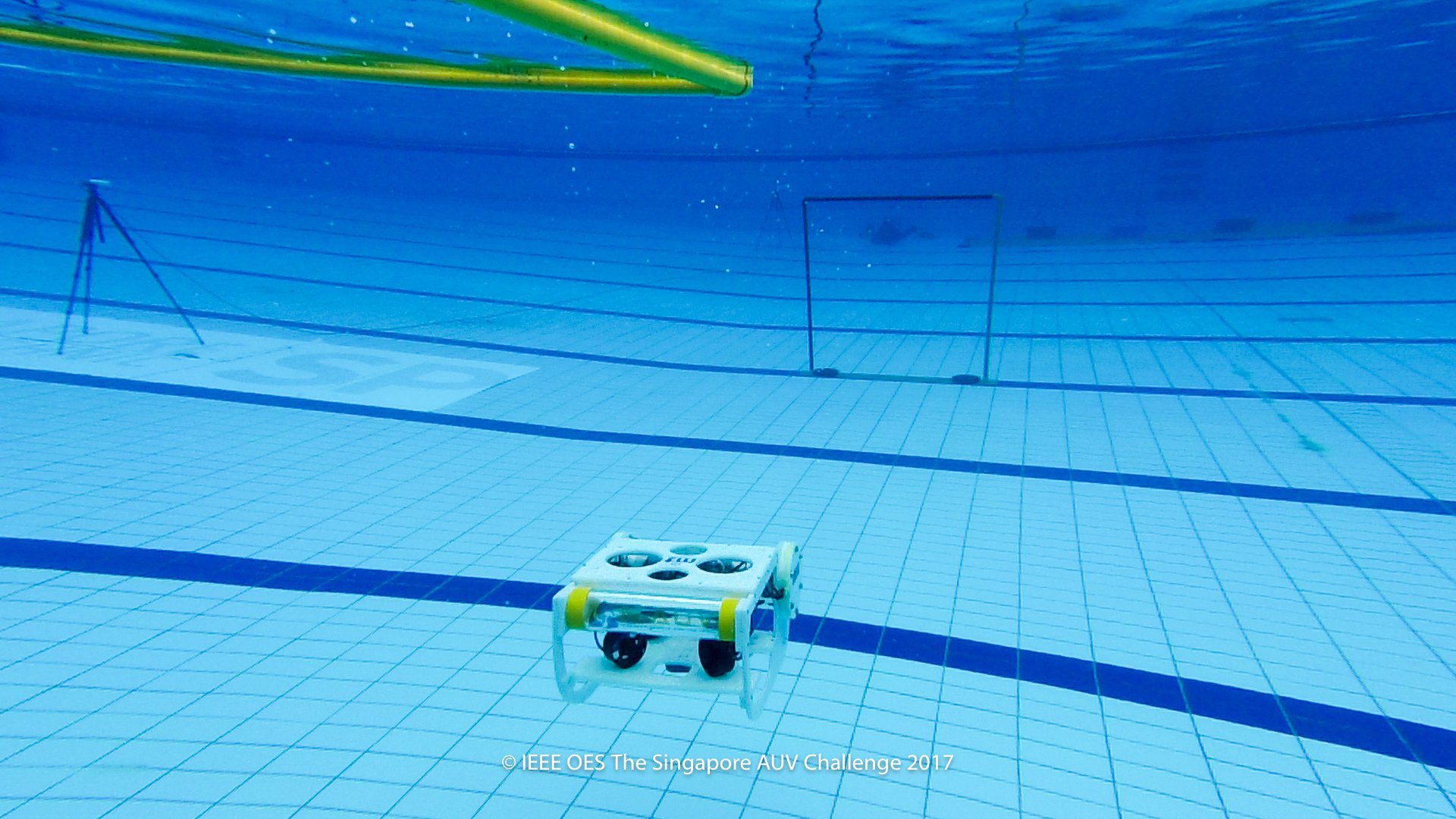
Picture of the Arena from 2017 Competition.
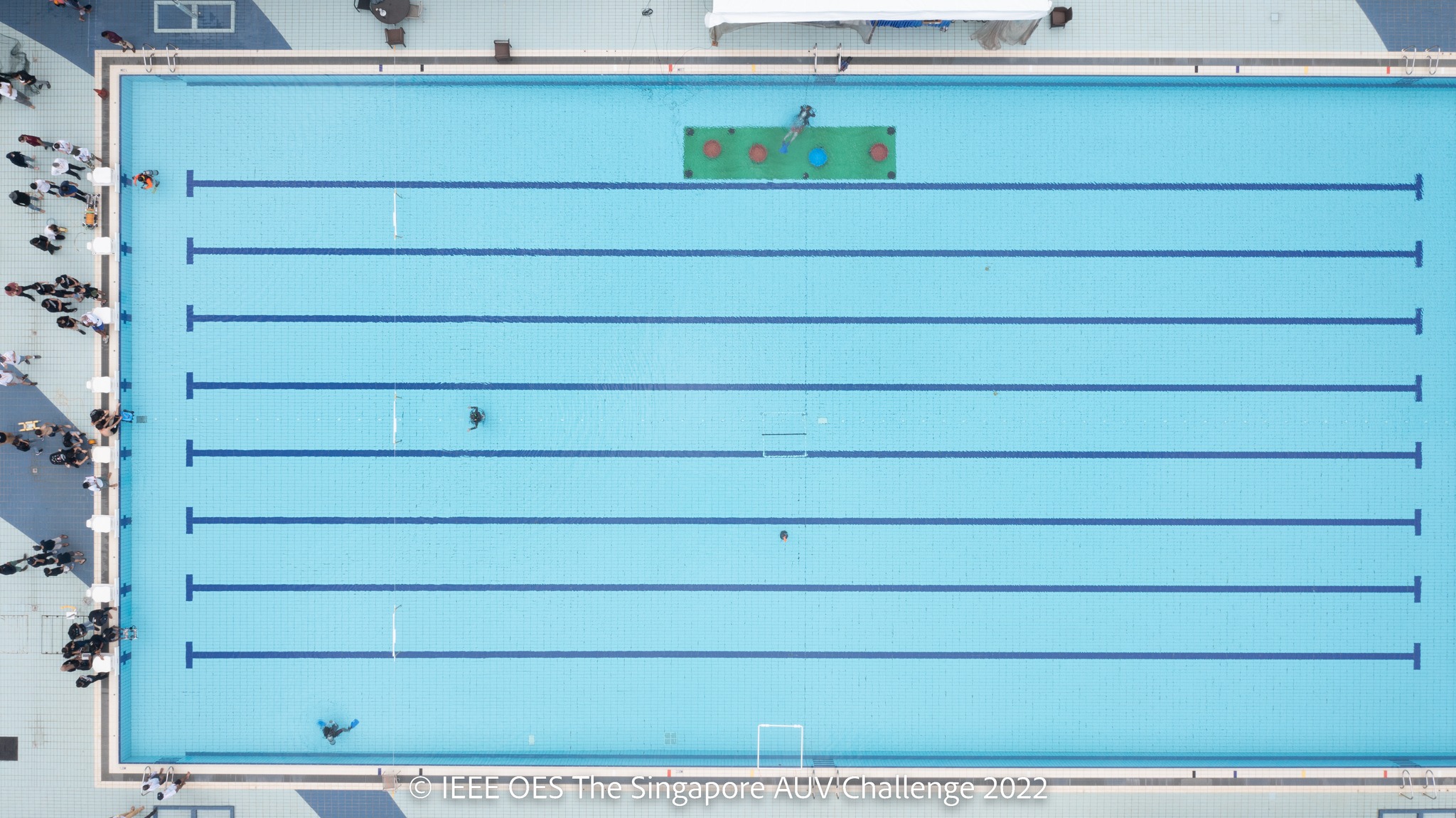
Picture of the Arena from 2022 Competition.
Qualification Arena(s)
The qualification rounds would be held on the side of the main arena.
The qualification starting line is a marked 1m wide section of the pool wall from where the AUV should be deployed from. The AUV has to touch the wall at the begining of the run.
At approximately 10m from the starting line the qualification gate is hanging from the surface of the water. The AUV has to go through the gate completely to get 1 qualifying point. If the AUV touches ANY of the 3 sides of the qualification gate, the attempt is considered a failure.
Specification of props
| Prop | Description | |
|---|---|---|
| 1 | Qualification Gate | 150cm wide and ~100cm deep gate hanging from the water surface with orange markings on both port and starboard sides. |
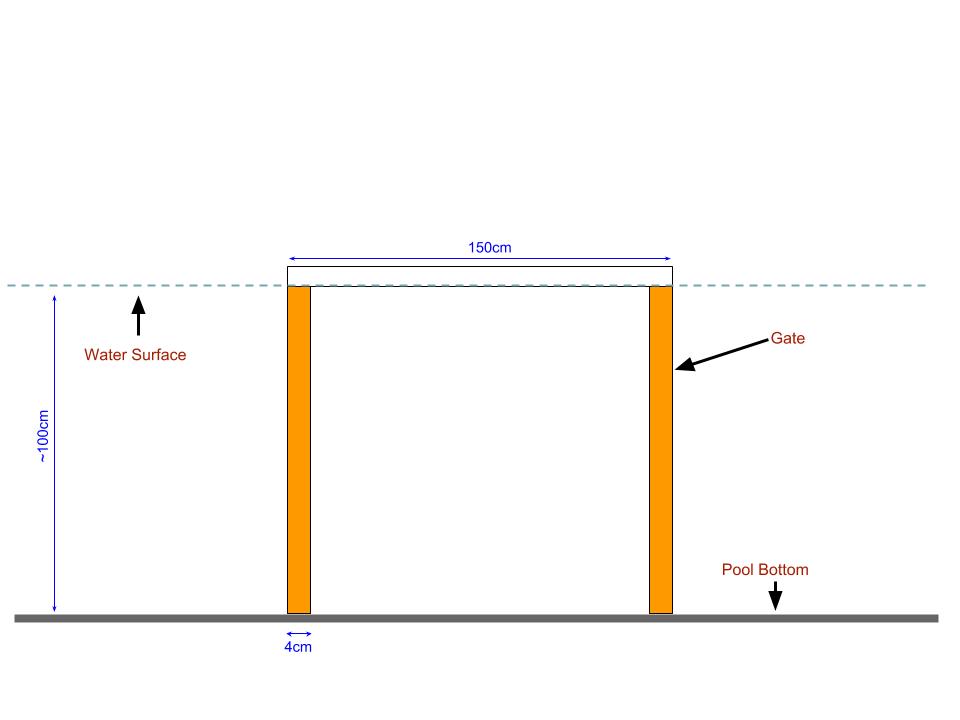
Front-view of the qualification gate.
Starting Zone
The starting zone is a 140×140cm area marked on the surface of water. The teams must start their AUVs from this area. The team may only place the AUV at the water surface, it must autonomously submerge before leaving the starting zone. Teams may also place their communication equipment in the starting zone.
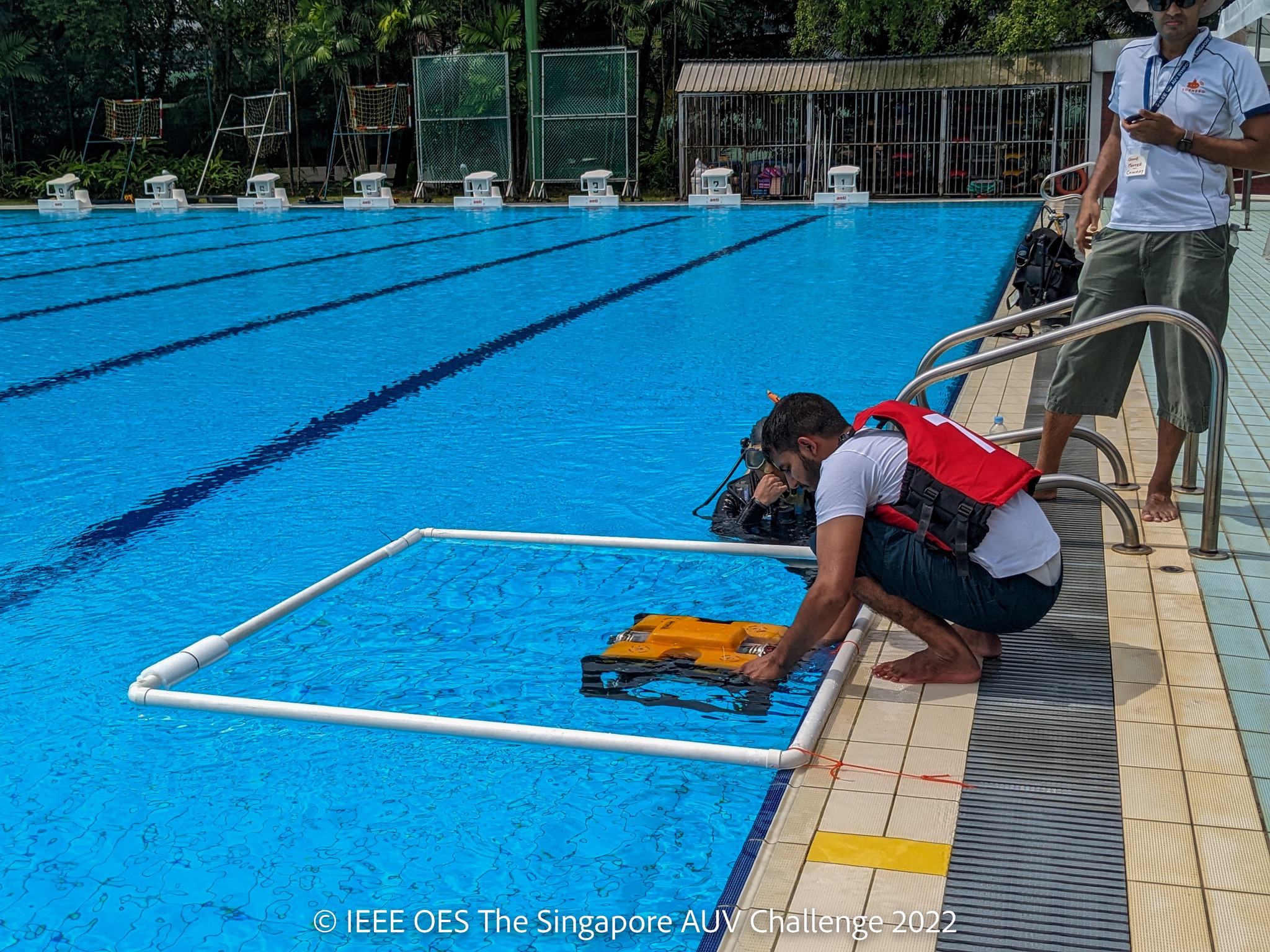
Picture of the Starting Zone from 2022 Competition.
Tasks
There are 4 tasks in the challenge:
The first task, Navigation, is mandatory and must be completed before attempting any other task. The other tasks can be attempted in any order. Surfacing at any point signifies end of the attempt.
1. Navigation
The aim of this task is to swim through a gate placed at the bottom of the pool. The gate may be located anywhere on a horizontal line, parallel to the side of the swimming pool, approximately 12m away from the starting zone. See Figure 4. The AUV has to swim through the 150 cm tall gate without touching the gate.
A orange flare may be located anywhere in a rectangular zone 4m-8m from side of the arena, before the gate. The AUV has to avoid touching the orange flare. Any part of the AUV touching the orange flare causes an immediate abort of the attempt.
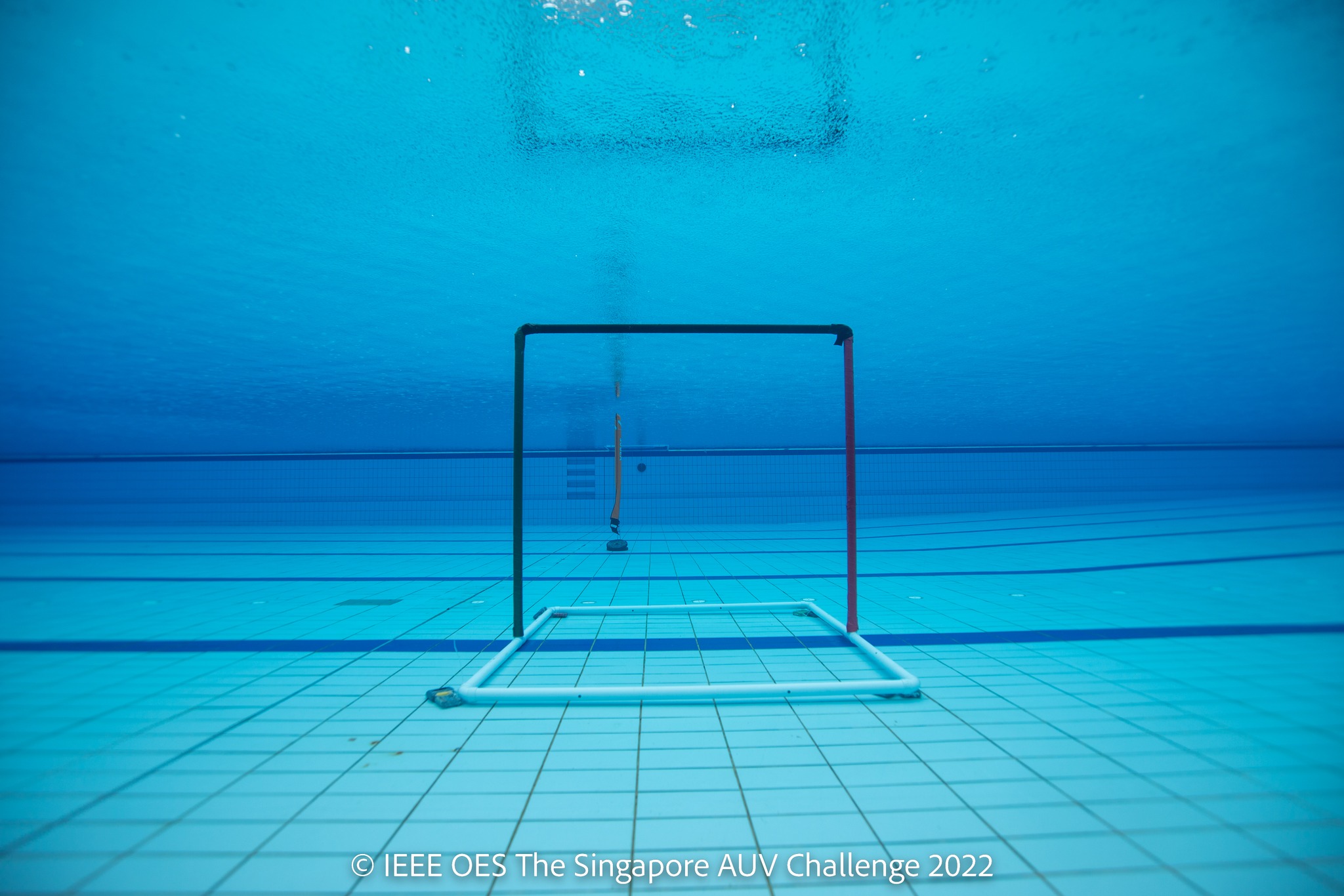
Picture of the gate from 2022 Competition.
Points
If the AUV successfully passes through the gate,15 Points will be awarded.
Specification of props
| Prop | Description | |
|---|---|---|
| 1 | Gate | 150cm wide and 150cm tall gate with striped red and green markings on port and starboard sides respectively. |
| 2 | Orange Flare | 150cm tall and ~15cm diameter flare, and orange in color. |
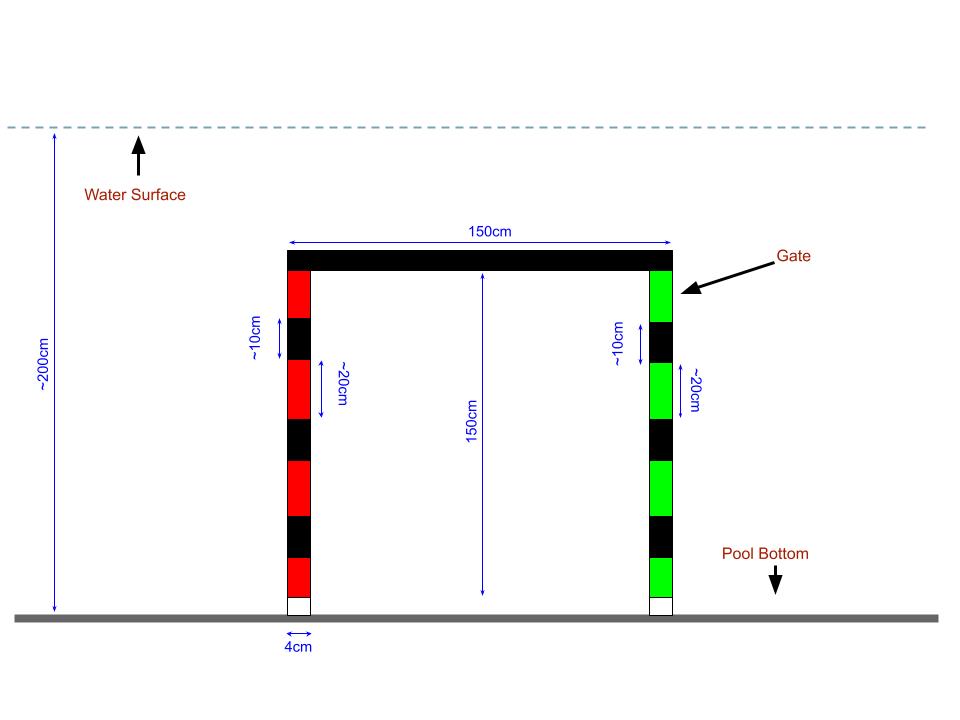
Front-view of the gate.
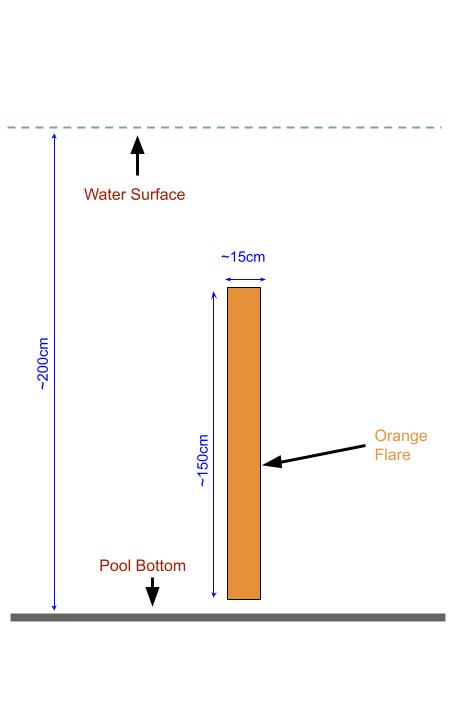
Front-view of the orange flare.
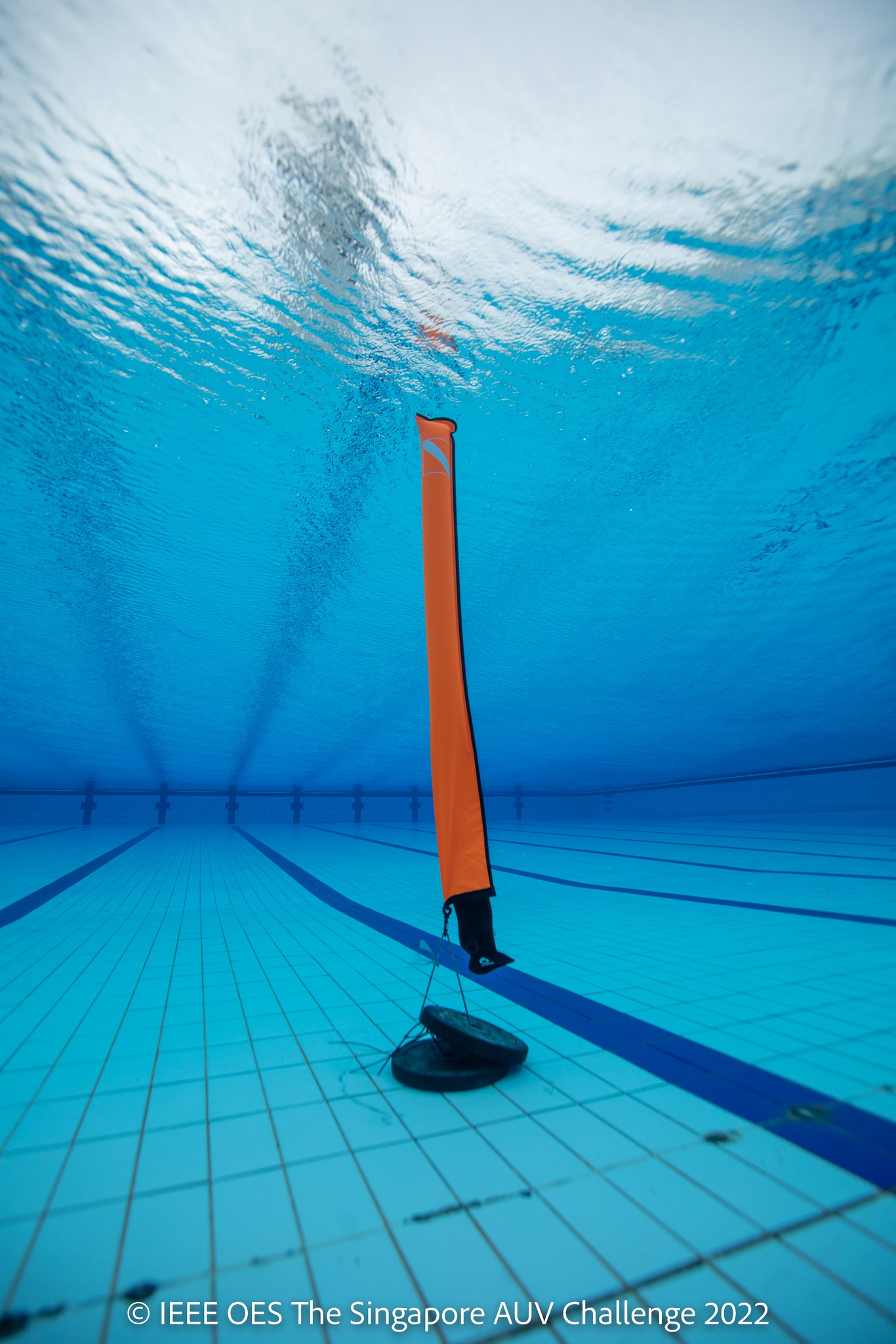
Orange flare from 2022 Competition.
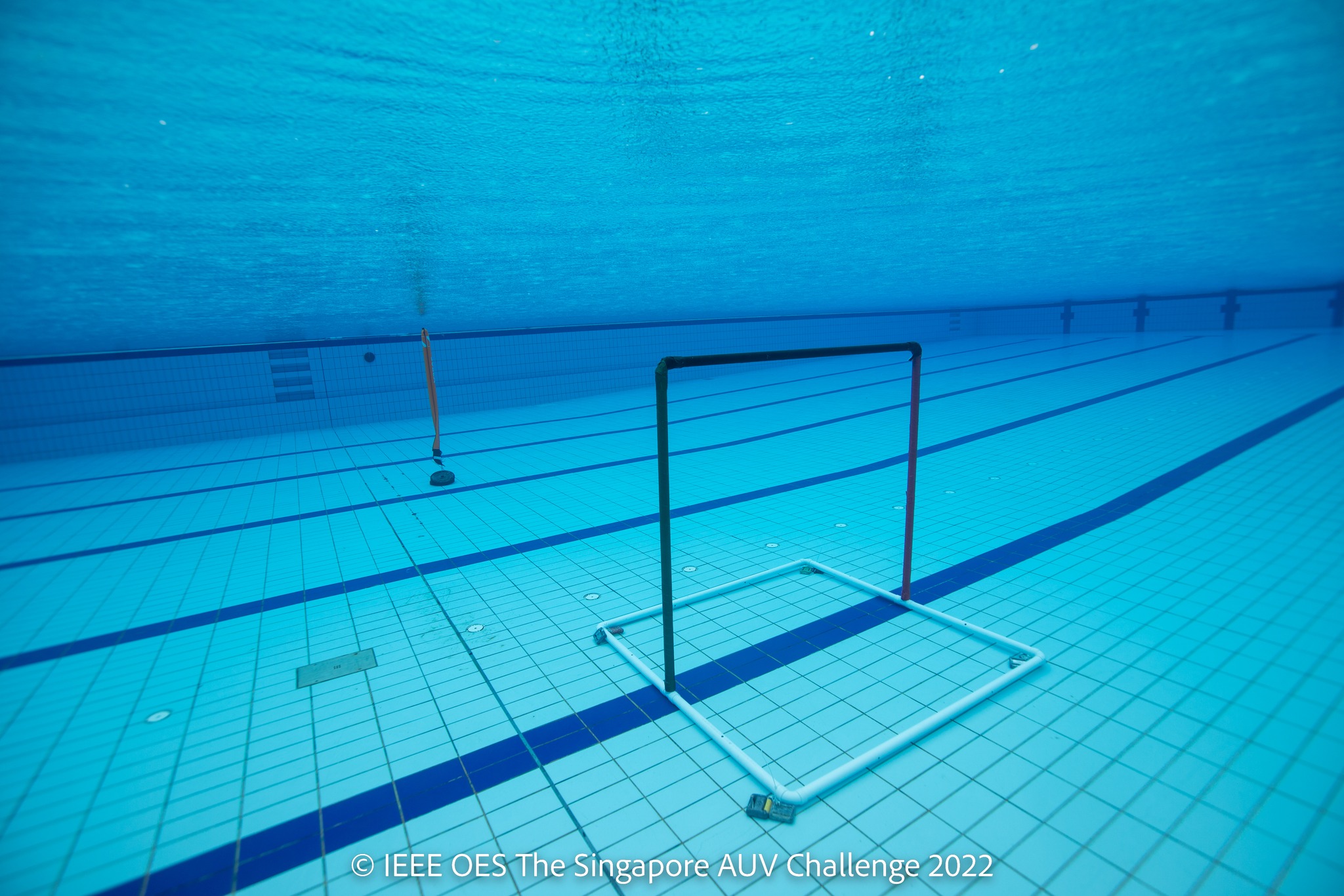
Gate and orange flare from 2022 Competition.
2. Target Acquisition
The aim of the task is to detect and acquire a target among a series of drums at the bottom of the pool, in the target zone.
A target zone is defined by a green colored mat laid out on the floor of the pool. The mat is 8m x 2m in size. Figure 4. shows the location of the mat with respect to the arena.
There are 4 colored drums in the arena. All of them are on the mat. One of the drums, chosen at random, will be blue in color, while the rest are red in color. One of the red drums, chosen at random, will contain an acoustic pinger. The AUV needs to drop a ball in one of the drums to successfully complete this task. Points will be awarded based on which drum the ball is dropped into. In the event of multiple balls being dropped, only the first ball is taken to consideration.
The location of the red drum which contains the acoustic pinger may be randomized between attempts, as may be the order of the drums. The order of the drums and location of the pinger will be decided by the organizing committee.
Points
Points will be awarded as follows.
- Drop the ball in the blue drum: 30 Points
- Drop the ball in the red drum with the pinger: 50 Points
- Dropping the ball in any other red drum: 10 Points
Specification of props
| Prop | Description | |
|---|---|---|
| 1 | Drum | 60cm in diameter and 30cm in depth. |
| 2 | Ball | 3.5-4.5cm in diameter and weigh no more than 200g in air. Provided by teams. |
| 3 | Drum Pinger | RJE International Pinger Model No. ULB-362B/45 kHz. |
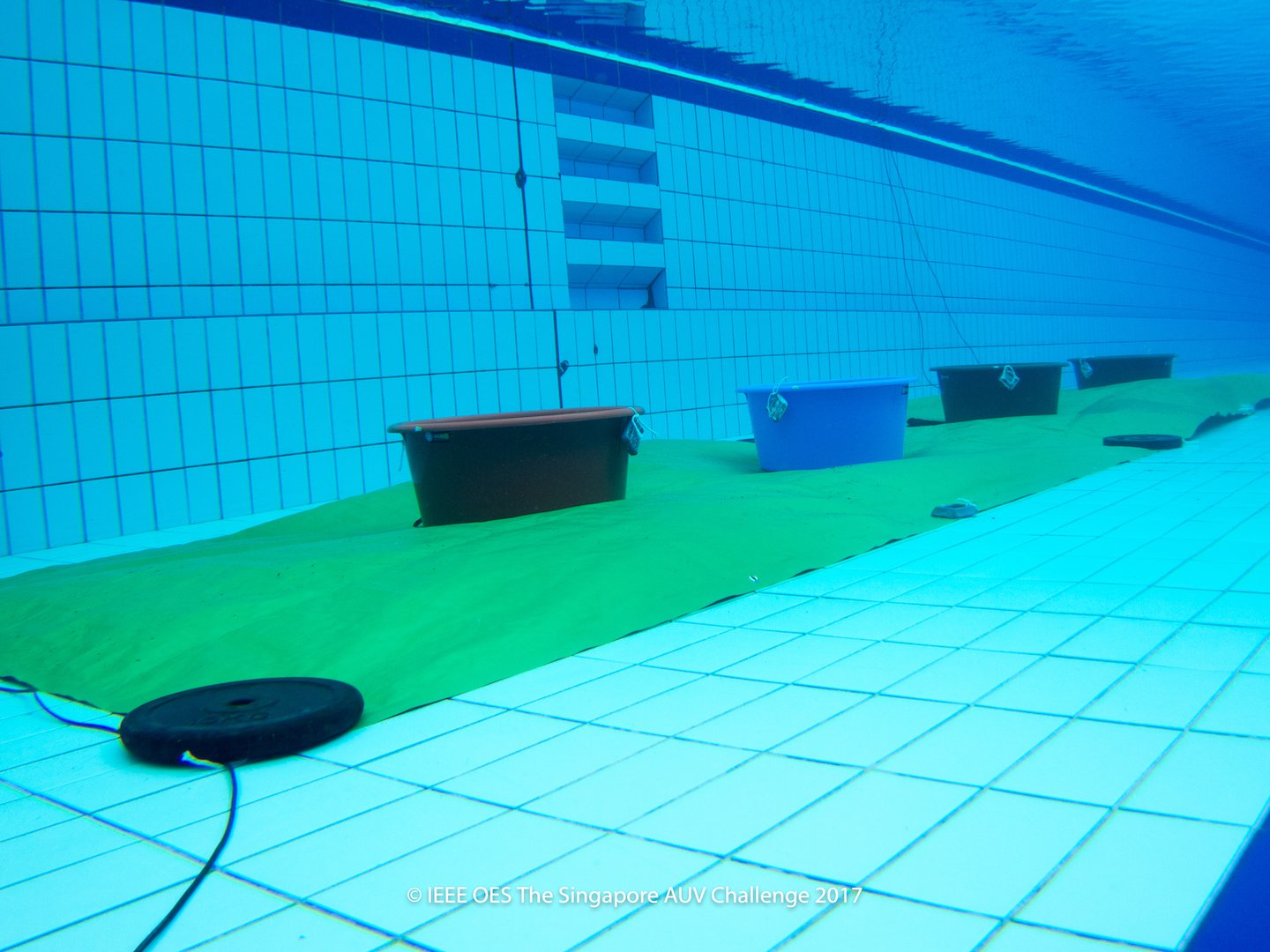
Picture target zone and drums from the 2017 Competition.

Picture of a 45kHz pinger.
3. Target Reacquisition
The aim of this task is to reacquire a previously detected target.
This task is only attempt-able if the Target Acquisition has been successfully completed. Furthermore, the AUV has to leave the target zone, before it can attempt the Target Reacquisition task. Every part of the AUV needs to clear the target zone, before it can be considered outside the target zone.
After the AUV is outside the target zone, it needs to reacquire the target and pick up the ball that it dropped in the Target Acquisition task. The AUV has to hold on to the ball till the end of attempt to successfully complete this task.
This task does not have to be attempted immediately after Target Acquisition task, other tasks may be attempted in between.
Points
If the AUV successfully picks up the ball and holds on to it till the end of the attempt, 60 Points will be awarded.
Specification of props
| Prop | Description | |
|---|---|---|
| 1 | Target zone | Green mat 8m x 2m in size. |
| 2 | Ball | Same ball used in target acquisition task. Provided by the teams. |
4. Communication & Localization
The aim of this task is to localize on coloured flares and bump them causing a golf ball to drop out. There are 3 coloured flares in the arena, one red coloured flare, one yellow coloured flare and one blue coloured flare. These flares could be located anywhere within the main arena. The AUV may locate and bump a flares in a specified order, which may be communicated to the AUV, to receive bonus points.
On every attempt, after the AUV successfully completes the Navigation task, the team will be informed of the order in which the flares have to be bumped. The specified order may be different between different attempts. The order will specified using the following notation, joined by a hyphen (-).
- Red : R
- Yellow : Y
- Blue : B
So, for example, specifying the order as R-B-Y would mean that the AUV has to bump the red flare first, followed by the blue flare and finally the yellow flare.
The team is then allowed to communicate the order with their AUVs using their communication equipment.
Points
Points would be awarded as follows.
- Successfully causes the ball to drop from any flare via contact or proximity : 20 Points per flare
- Successfully causes the ball to drop all 3 flares in the specified order : 60 Points (in addition to above)
Specification of props
| Prop | Description | |
|---|---|---|
| 1 | Red Flare | 80cm tall, ~1.6cm in diameter, and red in color. |
| 1 | Yellow Flare | 80cm tall, ~1.6cm in diameter, and yellow in color. |
| 1 | Blue Flare | 80cm tall, ~1.6cm in diameter, and blue in color. |
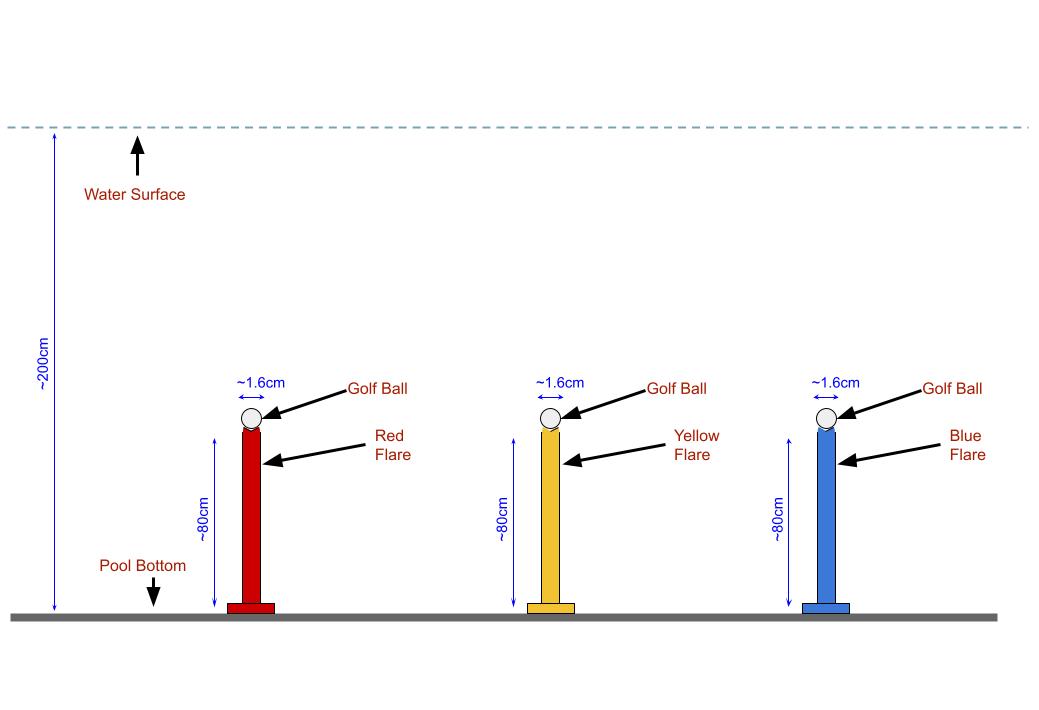
Side-view of the flares.
Surfacing
Breaching the surface any point during the mission causes end of the current attempt, the total points for that attempt will be computed based on the tasks accomplished in that attempt and the timing bonus (if applicable) and a 5 Points bonus for ending. The team may wish to retry if they still have time left.
Aborting
At any time during the mission, current attempt can be aborted, by indicating to the Game Master. The divers would then retrieve the AUV back to the starting zone. The timing for the current attempt is stopped at the time of indication. The team may wish to retry if they still have time left.
In the case of an aborted attempt, the team would be awarded the points for all previously successfully completed tasks during the current attempt.
Automatic Abort
If the AUV touches the bottom or the side walls of the pool for a cumulative time of more than 10 seconds or 5 discrete touches, the current attempt would be automatically aborted. The divers would then retrieve the AUV back to the starting zone. The team may wish to retry if they still have time left.
In the case of an automatic aborted attempt, the team would be awarded the points for all previously successfully completed tasks during the attempt.
Timing Bonus
At the end of an attempt, as long as the AUV has successfully completed at least 2 tasks, the Navigation task and any other task, bonus points proportional to the remaining time will be awarded in accordance with the following formula.
Bonus points = (900 - RUN_TIME) • 0.03
For eg. For a run time of 420s, Bonus = (900-420)•0.03 = 14.4 Points
Penalties
There are penalty points for touching the floor or wall of the pool at any time, and also for touching the gate during a specific attempt. This penalty points are:
| Description | Penalty Points | |
|---|---|---|
| 1 | Touching the gate | 2 |
| 2 | Touching the bottom of the pool or wall | 5 |
There is no penalty for your actuator touching the inner part of the drum during the act of deploying or retrieving during Task 2 and 3. However, touching the outer part of the drum or with the vehicle body can incur the same penalty as touching the pool floor.
Examples
Here are some examples scenarios and how they would be scored.
Example 1
- Team launches AUV from starting zone.
- AUV crosses the gate and completes the Navigation task, but touches the side of the gate while passing through.
- AUV can't find the location next task and ends the mission by rising to the surface.
| Task | Points | |
|---|---|---|
| 1 | Navigation Task | 15 |
| 2 | Touching the gate | -2 |
| 3 | Surfacing | 5 |
| Attempt Total | 18 |
Example 2
- Team launches AUV from starting zone.
- AUV crosses the gate and completes the Navigation task.
- AUV can't find the location of the next task and has to aborted and retrieved by divers.
| Task | Points | |
|---|---|---|
| 1 | Navigation Task | 15 |
| Attempt Total | 15 |
Example 3
- Team launches AUV from starting zone.
- AUV crosses the gate and completes the Navigation task.
- AUV find the drums and successfully drops the ball in the blue drum, but touches the side of the wall momentarily while looking for the drum.
- AUV tries to find the flares, but can't find it and has to be aborted and retrieved by divers.
| Task | Points | |
|---|---|---|
| 1 | Navigation Task | 15 |
| 2 | Target Acquisation Task (Visual) | 30 |
| 3 | Touching the wall | -5 |
| Attempt Total | 40 |
Example 4
- Team launches AUV from starting zone.
- AUV crosses the gate and completes the Navigation task.
- AUV find the drums and successfully drops the ball in the blue drum.
- AUV locates the red flare and knocks off the golf ball.
- AUV surfaces with run time of 400 seconds.
| Task | Points | |
|---|---|---|
| 1 | Navigation Task | 15 |
| 2 | Target Acquisition Task (Visual) | 30 |
| 3 | Communication & Localization Task | 20 |
| 4 | Surface Bonus | 5 |
| 5 | Run time Bonus | 15 |
| Attempt Total | 105 |
Example 5
- Team launches AUV from starting zone.
- AUV crosses the gate and completes the Navigation task.
- Team is given the squence of R-B-Y for the flares.
- AUV find the drums and successfully drops the ball in the blue drum.
- AUV locates the red flare and knocks off the golf ball.
- AUV locates the yellow flare and knocks off the golf ball.
- AUV touches the bottom of the pool for more than 10 seconds while trying to find 3rd flare and gets automatically aborted by divers.
| Task | Points | |
|---|---|---|
| 1 | Navigation Task | 15 |
| 2 | Target Acquisation Task (Visual) | 30 |
| 3 | Communication & Localization Task | 40 |
| Attempt Total | 85 |
Example 6
- Team launches AUV from starting zone.
- AUV crosses the gate and completes the Navigation task.
- Team is given the squence of R-B-Y for the flares.
- AUV find the drums and successfully drops the ball in the blue drum.
- AUV locates the red flare and knocks off the golf ball.
- AUV locates the yellow flare and knocks off the golf ball.
- AUV locates the blue flare and knocks off the golf ball.
- AUV touches the bottom of the pool for more than 10 seconds while trying to find 3rd flare and gets automatically aborted by divers.
| Task | Points | |
|---|---|---|
| 1 | Navigation Task | 15 |
| 2 | Target Acquisation Task (Visual) | 30 |
| 3 | Communication & Localization Task | 60 |
| Attempt Total | 105 |
Example 7
- Team launches AUV from starting zone.
- AUV crosses the gate and completes the Navigation task.
- Team is given the squence of R-B-Y for the flares.
- AUV find the drums and successfully drops the ball in the blue drum.
- AUV locates the red flare and knocks off the golf ball.
- AUV locates the blue flare and knocks off the golf ball.
- AUV locates the yellow flare and knocks off the golf ball.
- AUV surfaces with run time of 400 seconds.
| Task | Points | |
|---|---|---|
| 1 | Navigation Task | 15 |
| 2 | Target Acquisation Task (Visual) | 30 |
| 3 | Communication & Localization Task | 120 |
| 4 | Surface Bonus | 5 |
| 5 | Run time Bonus | 15 |
| Attempt Total | 185 |
Specification of AUV
Size
- The AUV must fit within a 140 × 100 × 100 cm box.
- An AUV with dimension of less than 70 cm × 50 cm × 50 cm will be given bonus 10 points.
- The AUV must not weigh more than 52 kg in air.
- An AUV weighing less than 42 kg in air will be given bonus 10 points.
Power
- Power must be self contained.
- Tethers of any sort are not allowed, except when calibrating AUV sensors during practice rounds.
- The voltage of the power source used by each AUV must not exceed 24VDC.
Safety
- AUVs must not leak and pollute the pool.
- AUVs must be designed and manufactured as to pose no danger of any kind to anyone or anything at the venue. This includes making sure that thrusters/propeller blades are shrouded.
- AUVs must have a kill switch that turns off the vehicle including thrusters, or any other population mechanism.
- The kill switch must be easily accessible to a diver. This must be marked in bright color.
- Pressure of any compressed gas used must not exceed 6 bars.
- AUV must be completely autonomous.
- The use of explosives, fire or hazardous chemicals is prohibited. Certified lithium batteries are allowed.
- If lasers are used, they must be of class 2 or lower. Care must be taken to protect all persons at the venue from harm. Beams must be oriented in such a fashion that they cannot shine into the eyes of the spectators.
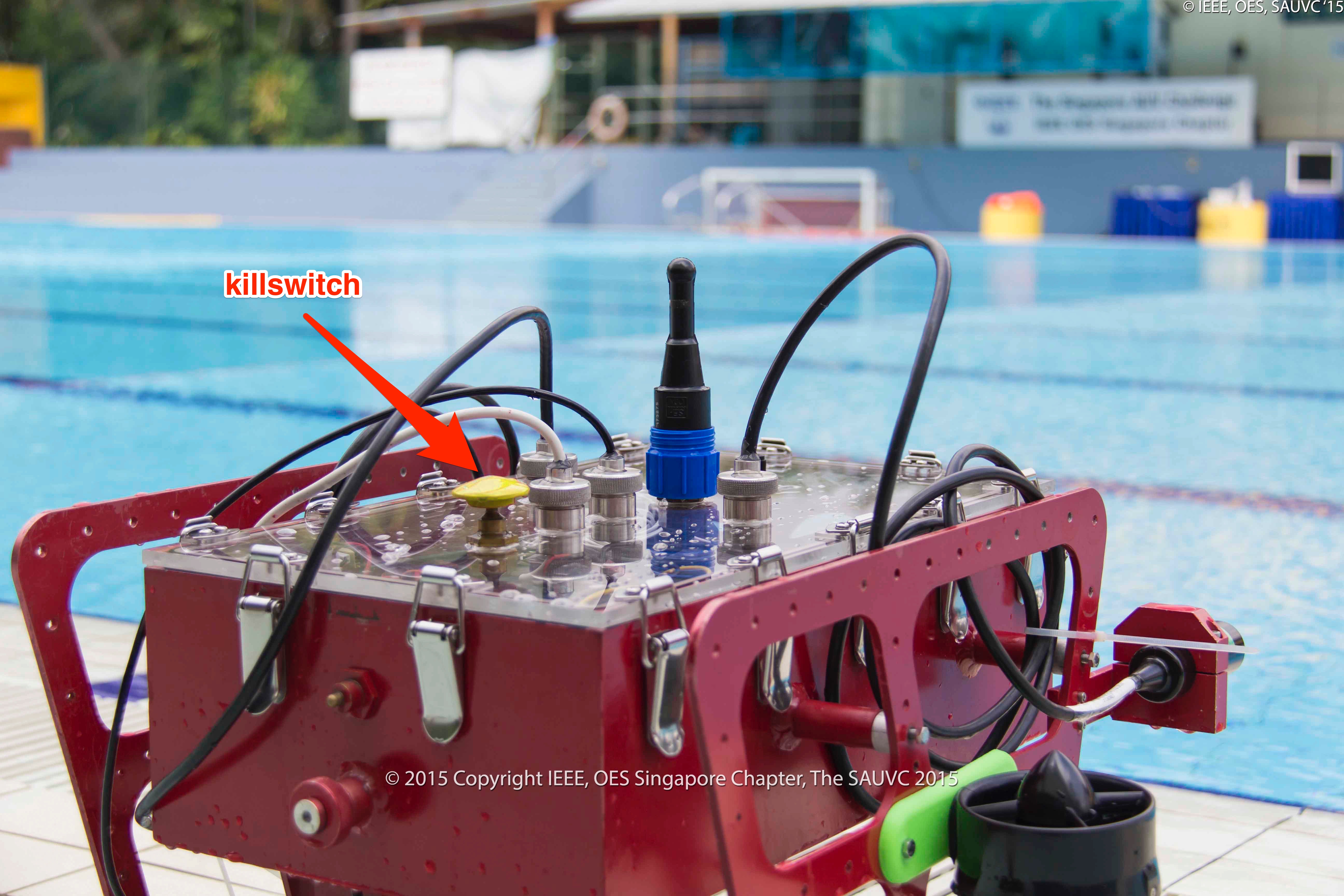
Example a kill switch on an AUV from 2015 Competition.
Communications
- Untethered communications with the AUV are allowed in the main arena.
- AUVs can carry their own "underwater" communication equipment.
- Teams are allowed to deploy "top-side" communication equipment in the starting zone during the game.
- All "underwater" communication equipment on the AUV MUST fit within the size limits for the AUV.
- Any "underwater" communication equipment on the AUV is considered a part of the AUV.
- The "top-side" communication equipment MUST fit within the dimensions of the starting zone and weigh no more than 42 kg in air.
- Any "top-side" communication equipment must stay within the starting zone. It may be submerged in the water, and can have a single tether to the surface.
- Any "top-side" communication equipment submered in the water, must not leak and pollute the pool.
- Any "top-side" communication equipment must be removed at the end of the game.
Game Procedure
Sequence of events during the competition
- AUVs will undergo weight and size check. Bonus points, if applicable, will be awarded.
- AUVs will be tested for battery, oil or lubricant leak check, and a waterproofness check. Failing either would bar the team from attempting to qualify until the AUV passes the checks.
- Team will proceed to qualifying round. The bonus points for size and weight is applicable only if the team passes the qualifying round.
- Top 15 qualified teams (according to qualification score and the qualification time) will proceed to the final rounds of competition.
- The final round will be held in the main arena.
Practice Rounds
- Teams will be allowed to practice in the main arena after they successfully complete the qualifying round, subject to availability of time slots and the schedule during the competition.
- No tethers are allowed at ANY time inside the main arena.
- Teams will be allowed calibrate their AUV sensors with tethers, at the edge of the pool, with the vehicle held stationary.
Length of a game
- Each team is given 15 minutes to complete the tasks.
- In any of the following cases, the game ends immediately.
- Disqualification is announced in the game.
- When the Judges determine that the game cannot continue.
- Setting up of AUV
- Five minutes is given for setting up the AUV before the game starts.
- No more than two members of respective teams can engage in setting up of their AUV at the poolside.
- The two designated members setting up must wear life jackets. Failure to do so may result in disqualification.
- Any team that fails to complete setting their AUV within five minutes can resume the setting up again once the game starts.
- Setting up during the game uses the allocated time for the tasks and game.
- The AUV can only start from the start zone. This is the only place where the AUV is allowed to be on the water surface.
- The AUV must start its maneuver only after it has completely submerged in the water.
Retries
- A retry attempt can be made only after the Judges' permission.
- The AUV will be passed to the two designated team members standing beside the pool by the divers.
- A retry would mean that the AUV starts from the start zone with 0 points
- A maximum of 15 minutes is allowed including all the retries.
- The attempt with the highest score (including retries) will be considered for final scoring.
Certificate of Participation
- Teams whose AUVs successfully complete the qualifier round will receive Certificate of Participation.
- Teams whose video submissions have been accepted & attend the competition will receive a Certificate of Participation.
- Failing the above two criteria, no Certificate of Participation will be awarded.
General Restrictions
- Team members are not allowed inside the swimming pool at any point during the game.
- Team members may not disturb the water surface once the game starts.
- Members of other teams are not allowed in the game area.
- Nobody is allowed to wear any footwear near the pool area.
- The Judges may suspend the challenge if weather turns unfavorable.
- The pool area must be evacuated in case of lightning.
Disqualification
Teams may be disqualified if :
- Oil or lubrication leaks causing the pollution of pool.
- Battery leak causing the pollution of pool.
- The AUV damages or tries to damage the arena, facilities or equipment.
- The team performs any acts that are not in the spirit of fair play.
- The team fails to obey instructions or warnings issued by the Judges or Game Master.
- If the team does not abide by the the general restrictions.
Others
- The legitimacy of any actions not provided in this rulebook will be subject to discretion of the Judges.
- The dimensions, weights, etc. of the field, facilities and equipments stated in this rulebook have a margin of error of ±5% unless otherwise stated. However the dimensions and weights of the AUVs as stated in the rule book are the maximum and cannot be deviated.
- The Judges may demand additional explanations on safety issues when the safety of a vehicle is deemed to be in question.
Feedback
If you spot any errors in the rulebook or have queries about the rules, please email rules@sauvc.org or contact us through our website.